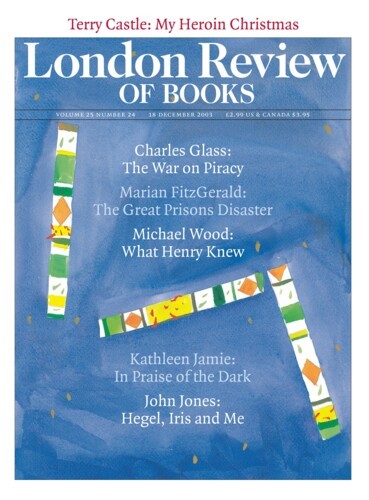It’s a strange thing when, in the course of a murder trial at the Old Bailey, a cracked plastic bath is carried into the courtroom, and a second strange thing when no one at the time thinks to ask why on earth it was needed there. The bath had been unplumbed from a house in Cambridgeshire, driven to London and, like a fair few of the arrested before it, been roughed up when in police custody, bearing two cracks once it was on display in the courtroom where before it had only one. This extraordinary act of household removal formed part of the proceedings in the trial of Ian Huntley, the man who is accused of the murder of two small girls in Soham, whose deaths, as we now know by his own peculiar account, took place in his bathroom. Since one of the girls is held to have drowned in the bath, the prosecution saw fit to have this detachable part of the crime scene brought into court, to authenticate a pathologist’s testimony, even though there was nothing remotely unorthodox about Huntley’s bath that might have demanded its exhibition before a jury deemed otherwise incapable of imagining what it could be like. Reading of this elaborate forensic breakthrough, the mind went back – as how could it not? – to the case of George Joseph Smith, a triple murderer of ninety years ago, all three of whose women victims were drowned in the bath but in three widely dispersed bathrooms, so that if they had been given in evidence in the ‘brides in the bath’ case of legend, the tubs would have needed to be brought from, respectively, Herne Bay, Blackpool and Highgate. Presumably, once its presence is no longer required at the Old Bailey, the Soham bath, rather than being reunited with its water supply, will go off to become landfill, unless, that is, Madame Tussaud’s put in a decent offer for it – a waxworks, not a court of law is where it certainly belongs.
The ghoulish and redundant subpoena-ing of Huntley’s bath is not the only novelty to give rise to questions about the way in which his trial is being stage-managed. For the unfortunate jury, the frisson count has been high. Before they were invited to set eyes on the bath, they had been taken first to Soham, to walk the route the girls had followed on the way to Huntley’s house, and then to the ditch a good many miles away in which the bodies were later found. They had also been shown what was described in reports as a ‘dramatic reconstruction’, in the form of a video clip in which a policeman went through the motions of finding the girls’ burned clothing, and another ‘video reconstruction’ of a ‘black plastic bin bag, indicating where his hands were alleged to have touched it’ (sic; I quote from the Times on-line). What the jury could have learned from their charabanc trip, or from the reconstructions, which they couldn’t have learned in the normal way from seeing, if need be, pictures of Soham (of whose layout there was already a scale model in the courtroom) and the ditch and listening to the verbal evidence from witnesses, is unclear. What is clear is that the assumedly enhanced immediacy of techniques of this kind, with their echoes of TV programmes such as Crimewatch, is intended not to inform a jury but to disturb it, and we should object to their being introduced into the conduct of a case which was already emotive enough by its awful nature. Far from countering, as one might have hoped, the wraparound sentimentality with which cases where the victim or victims are children are sure to be reported, the current Old Bailey trial is playing blatantly into it, by apparently trying to ensure that the jury’s feelings, to say nothing of our own, are under constant assault.
Let’s hope it’s not the Attorney-General who has been nobbling the Crown Prosecution Service, to get them to go about their business in this media-genic fashion, especially when, in the same week as the Soham bath was paraded at the Old Bailey, he threatened those same media with bringing in much tighter legal curbs on the prejudicial coverage of potentially lurid cases, such as either imputes guilt to the accused before they even make it into the dock – as with David Blunkett’s recent disgraceful remarks about the terrorist suspect in Gloucester – or else works itself up into a populist frenzy of innuendo during the proceedings. On the same occasion, Lord Goldsmith endorsed the complaint of the judge in the Huntley trial that some of the reporting of it had been ‘unacceptable’, if not to the extent that the defendants might not be getting a ‘fair trial’. We’d all like to believe they are, but when juries are carted off to gaze melancholically down into soggy ditches where there’s nothing of significance to see, you begin to wonder.
Send Letters To:
The Editor
London Review of Books,
28 Little Russell Street
London, WC1A 2HN
letters@lrb.co.uk
Please include name, address, and a telephone number.

